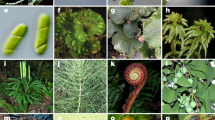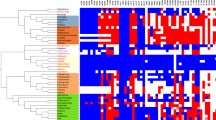Abstract
Orthologs generally are under selective pressure against loss of function, while paralogs usually accumulate mutations and finally die or deviate in terms of function or regulation. Most ortholog detection methods contaminate the resulting datasets with a substantial amount of paralogs. Therefore we aimed to implement a straightforward method that allows the detection of ortholog clusters with a reduced amount of paralogs from completely sequenced genomes. The described cross-species expansion of the reciprocal best BLAST hit method is a time-effective method for ortholog detection, which results in 68% truly orthologous clusters and the procedure specifically enriches single-copy orthologs. The detection of true orthologs can provide a phylogenetic toolkit to better understand evolutionary processes. In a study across six photosynthetic eukaryotes, nuclear genes of putative mitochondrial origin were shown to be over-represented among single copy orthologs. These orthologs are involved in fundamental biological processes like amino acid metabolism or translation. Molecular clock analyses based on this dataset yielded divergence time estimates for the red/green algae (1,142 MYA), green algae/land plant (725 MYA), mosses/seed plant (496 MYA), gymno-/angiosperm (385 MYA) and monocotyledons/core eudicotyledons (301 MYA) divergence times.



Similar content being viewed by others
References
Abascal F, Zardoya R, Posada D (2005) ProtTest: selection of best-fit models of protein evolution. Bioinformatics 21:2104–2105
Alexeyenko A, Tamas I, Liu G, Sonnhammer EL (2006) Automatic clustering of orthologs and inparalogs shared by multiple proteomes. Bioinformatics 22:e9–e15
Altschul SF, Madden TL, Schaffer AA, Zhang J, Zhang Z, Miller W, Lipman DJ (1997) Gapped BLAST and PSI-BLAST: a new generation of protein database search programs. Nucleic Acids Res 25:3389–3402
Armbrust EV, Berges JA, Bowler C, Green BR, Martinez D, Putnam NH, Zhou S, Allen AE, Apt KE, Bechner M, Brzezinski MA, Chaal BK, Chiovitti A, Davis AK, Demarest MS, Detter JC, Glavina T, Goodstein D, Hadi MZ, Hellsten U, Hildebrand M, Jenkins BD, Jurka J, Kapitonov VV, Kroger N, Lau WW, Lane TW, Larimer FW, Lippmeier JC, Lucas S, Medina M, Montsant A, Obornik M, Parker MS, Palenik B, Pazour GJ, Richardson PM, Rynearson TA, Saito MA, Schwartz DC, Thamatrakoln K, Valentin K, Vardi A, Wilkerson FP, Rokhsar DS (2004) The genome of the diatom Thalassiosira pseudonana: ecology, evolution, and metabolism. Science 306:79–86
Bell CD, Soltis DE, Soltis PS (2005) The age of the angiosperms: a molecular timescale without a clock. Evolution: Int J Org Evolution 59:1245–1258
Benjamini Y, Hochberg Y (1995) Controlling the false discovery rate: a practical and powerful approach to multiple testing. J Royal Stat Soc B 57:289–300
Birchler JA, Riddle NC, Auger DL, Veitia RA (2005) Dosage balance in gene regulation: biological implications. Trends Genet 21:219–226
Blair JE, Shah P, Hedges SB (2005) Evolutionary sequence analysis of complete eukaryote genomes. BMC Bioinformatics 6:53
Blanc G, Wolfe KH (2004) Functional divergence of duplicated genes formed by polyploidy during Arabidopsis evolution. Plant Cell 16:1679–1691
Butterfield NJ (2001) Paleobiology of the late Mesoproterozoic (ca. 1200 Ma) hunting formation, Somerset Island, Arctic Canada. Precam Res 111:235–256
Crane PR, Friis EM, Pedersen KR (1995) The origin and early diversification of angiosperms. Nature 374:27–33
Crum HA (2001) Structural diversity of bryophytes. The University of Michigan Herbarium, Bloomfield Hills
De Bodt S, Maere S, Van de Peer Y (2005) Genome duplication and the origin of angiosperms. Trends Ecol Evol 523:1–7
Do CB, Mahabhashyam MS, Brudno M, Batzoglou S (2005) ProbCons: probabilistic consistency-based multiple sequence alignment. Genome Res 15:330–340
Dutilh BE, Huynen MA, Snel B (2006) A global definition of expression context is conserved between orthologs, but does not correlate with sequence conservation. BMC Genomics 7:10
Fares MA, Byrne KP, Wolfe KH (2006) Rate asymmetry after genome duplication causes substantial long-branch attraction artifacts in the phylogeny of Saccharomyces species. Mol Biol Evol 23:245–253
Felsenstein J (1978) Cases in which parsimony and compatibility methods will be positively misleading. Syst Zool 27:401–410
Fitch WM (1970) Distinguishing homologous from analogous proteins. Syst Zool 19:99–113
Fitch WM (2000) Homology a personal view on some of the problems. Trends Genet 16:227–231
Gray MW, Burger G, Lang BF (2001) The origin and early evolution of mitochondria. Genome Biol 2:REVIEWS1018
Gutierrez RA, Green PJ, Keegstra K, Ohlrogge JB (2004) Phylogenetic profiling of the Arabidopsis thaliana proteome: what proteins distinguish plants from other organisms? Genome Biol 5:15
Hedges SB, Blair JE, Venturi ML, Shoe JL (2004) A molecular timescale of eukaryote evolution and the rise of complex multicellular life. BMC Evol Biol 4:2
Iseli C, Jongeneel CV, Bucher P (1999) ESTScan: a program for detecting, evaluating, and reconstructing potential coding regions in EST sequences. Int Conf Intell Syst Mol Biol, 138–148
Kenrick P, Crane PR (1997) The origin and early evolution of plants on land. Nature 389:33–39
Koonin EV, Fedorova ND, Jackson JD, Jacobs AR, Krylov DM, Makarova KS, Mazumder R, Mekhedov SL, Nikolskaya AN, Rao BS, Rogozin IB, Smirnov S, Sorokin AV, Sverdlov AV, Vasudevan S, Wolf YI, Yin JJ, Natale DA (2004) A comprehensive evolutionary classification of proteins encoded in complete eukaryotic genomes. Genome Biol 5:15
Lang D, Eisinger J, Reski R, Rensing SA (2005) Representation and high-quality annotation of the Physcomitrella patens transcriptome demonstrates a high proportion of proteins involved in metabolism among mosses. Plant Biol 7:228–237
Lee Y, Sultana R, Pertea G, Cho J, Karamycheva S, Tsai J, Parvizi B, Cheung F, Antonescu V, White J, Holt I, Liang F, Quackenbush J (2002) Cross-referencing eukaryotic genomes: TIGR Orthologous Gene Alignments (TOGA). Genome Res 12:493–502
Li L, Stoeckert CJ Jr, Roos DS (2003) OrthoMCL: identification of ortholog groups for eukaryotic genomes. Genome Res 13:2178–2189
Li WH, Yang J, Gu X (2005) Expression divergence between duplicate genes. Trends Genet 21:602–607
Martin W, Rujan T, Richly E, Hansen A, Cornelsen S, Lins T, Leister D, Stoebe B, Hasegawa M, Penny D (2002) Evolutionary analysis of Arabidopsis, cyanobacterial, and chloroplast genomes reveals plastid phylogeny and thousands of cyanobacterial genes in the nucleus. Proc Natl Acad Sci USA 99:12246–12251
Mulder NJ, Apweiler R, Attwood TK, Bairoch A, Barrell D, Bateman A, Binns D, Biswas M, Bradley P, Bork P, Bucher P, Copley RR, Courcelle E, Das U, Durbin R, Falquet L, Fleischmann W, Griffiths-Jones S, Haft D, Harte N, Hulo N, Kahn D, Kanapin A, Krestyaninova M, Lopez R, Letunic I, Lonsdale D, Silventoinen V, Orchard SE, Pagni M, Peyruc D, Ponting CP, Selengut JD, Servant F, Sigrist CJ, Vaughan R, Zdobnov EM (2003) The InterPro Database, 2003 brings increased coverage and new features. Nucleic Acids Res 31:315–318
Mushegian AR, Garey JR, Martin J, Liu LX (1998) Large-scale taxonomic profiling of eukaryotic model organisms: a comparison of orthologous proteins encoded by the human, fly, nematode, and yeast genomes. Genome Res 8:590–598
O’Brien KP, Remm M, Sonnhammer EL (2005) Inparanoid: a comprehensive database of eukaryotic orthologs. Nucleic Acids Res 33: D476–D480
Raymond J, Zhaxybayeva O, Gogarten JP, Gerdes SY, Blankenship RE (2002) Whole-genome analysis of photosynthetic prokaryotes. Science 298:1616–1620
Remm M, Storm CE, Sonnhammer EL (2001) Automatic clustering of orthologs and in-paralogs from pairwise species comparisons. J Mol Biol 314:1041–1052
Rensing SA, Fritzowsky D, Lang D, Reski R (2005) Protein encoding genes in an ancient plant: analysis of codon usage, retained genes and splice sites in a moss, Physcomitrella patens. BMC Genomics 6:43
Richardt S, Lang D, Frank W, Reski R, Rensing SA (2007) PlanTAPDB: a phylogeny-based resource of plant transcription associated proteins. Plant Physiol 143:1452–1466
Rost B (1999) Twilight zone of protein sequence alignments. Protein Eng 12:85–94
Saitou N, Nei M (1987) The neighbor-joining method: a new method for reconstructing phylogenetic trees. Mol Biol Evol 4:406–425
Sanderson MJ (2003) r8s: inferring absolute rates of molecular evolution and divergence times in the absence of a molecular clock. Bioinformatics 19:301–302
Schmidt HA, Strimmer K, Vingron M, von Haeseler A (2002) TREE-PUZZLE: maximum likelihood phylogenetic analysis using quartets and parallel computing. Bioinformatics 18:502–504
Shimodaira H, Hasegawa M (1999) Multiple comparisons of log-likelihoods with applications to phylogenetic inference. Mol Biol Evol 16:1114–1116
Sonnhammer EL, Koonin EV (2002) Orthology, paralogy and proposed classification for paralog subtypes. Trends Genet 18:619–620
Stajich JE, Block D, Boulez K, Brenner SE, Chervitz SA, Dagdigian C, Fuellen G, Gilbert JG, Korf I, Lapp H, Lehvaslaiho H, Matsalla C, Mungall CJ, Osborne BI, Pocock MR, Schattner P, Senger M, Stein LD, Stupka E, Wilkinson MD, Birney E (2002) The Bioperl toolkit: Perl modules for the life sciences. Genome Res 12:1611–1618
Tatusov RL, Fedorova ND, Jackson JD, Jacobs AR, Kiryutin B, Koonin EV, Krylov DM, Mazumder R, Mekhedov SL, Nikolskaya AN, Rao BS, Smirnov S, Sverdlov AV, Vasudevan S, Wolf YI, Yin JJ, Natale DA (2003) The COG database: an updated version includes eukaryotes. BMC Bioinformatics 4:41
Taylor TN, Kerp H, Hass H (2005) Life history biology of early land plants: deciphering the gametophyte phase. Proc Natl Acad Sci USA 102:5892–5897
Theissen G, Münster T, Henschel K (2001) Why don’t mosses flower? New Phytol 150:1–8
Troitsky AV, Melekhovets Yu F, Rakhimova GM, Bobrova VK, Valiejo-Roman KM, Antonov AS (1991) Angiosperm origin and early stages of seed plant evolution deduced from rRNA sequence comparisons. J Mol Evol 32:253–261
Vandepoele K, Van de Peer Y (2005) Exploring the plant transcriptome through phylogenetic profiling. Plant Physiol 137:31–42
Whelan S, Goldman N (2001) A general empirical model of protein evolution derived from multiple protein families using a maximum-likelihood approach. Mol Biol Evol 18:691–699
Wolfe KH, Gouy M, Yang YW, Sharp PM, Li WH (1989) Date of the monocot-dicot divergence estimated from chloroplast DNA sequence data. Proc Natl Acad Sci USA 86:6201–6205
Yang Z (1997) PAML: a program package for phylogenetic analysis by maximum likelihood. Comput Appl Biosci 13:555–556
Yoon HS, Hackett JD, Ciniglia C, Pinto G, Bhattacharya D (2004) A molecular timeline for the origin of photosynthetic eukaryotes. Mol Biol Evol 21:809–818
Acknowledgments
We would like to thank Wolfgang R. Hess, Clemens Kreutz and Klaas Vandepoele for helpful discussions. Financial support by the DFG (Re 837/10-1) is gratefully acknowledged.
Author information
Authors and Affiliations
Corresponding author
Additional information
Communicated by Y. Van de Peer.
Electronic supplementary material
Below is the link to the electronic supplementary material.
438_2007_257_MOESM2_ESM.xls
Supplementary data 2Names, numbers and annotation details (BLAST, GO, KEGG) of the 93 ortholog clusters as well as the results of the phylogenetic analyses (XLS 151 kb)
438_2007_257_MOESM4_ESM.xls
Supplementary data 4The comparison results of our method and InParanoid for Cyanidioschyzon merolae and Chlamydomonas reinhardtii (XLS 172 kb)
Rights and permissions
About this article
Cite this article
Zimmer, A., Lang, D., Richardt, S. et al. Dating the early evolution of plants: detection and molecular clock analyses of orthologs. Mol Genet Genomics 278, 393–402 (2007). https://doi.org/10.1007/s00438-007-0257-6
Received:
Accepted:
Published:
Issue Date:
DOI: https://doi.org/10.1007/s00438-007-0257-6




